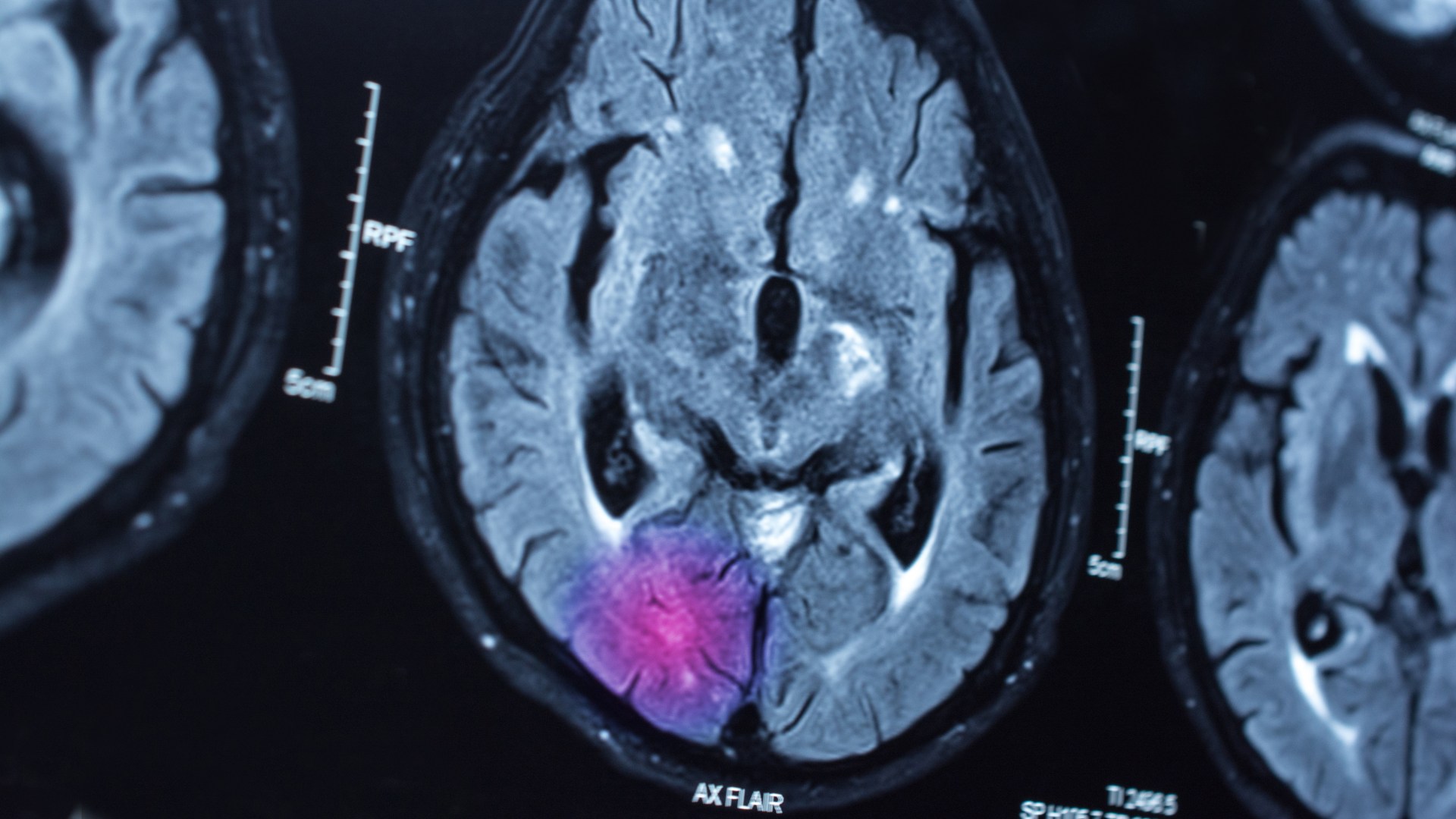I watched the CAT scan images appear on the screen, one by one. The baby’s head was mostly empty. There were only thin slivers of brain—a bit of brain tissue at the base of the skull, and a thin rim around the edges. The rest was water.
Her parents had feared this. We had seen it on the prenatal ultrasound; the CAT scan, hours after birth, was much more accurate. Katie looked like a normal newborn, but she had little chance at a normal life. She had a fraternal-twin sister in the incubator next to her. But Katie only had a third of the brain that her sister had. I explained all of this to her family, trying to keep alive a flicker of hope for their daughter.
I cared for Katie as she grew up. At every stage of Katie’s life so far, she has excelled. She sat and talked and walked earlier than her sister. She’s made the honor roll. She will soon graduate high school.
I’ve had other patients whose brains fell far short of their minds. Maria had only two-thirds of a brain. She needed a couple of operations to drain fluid, but she thrives. She just finished her master’s degree in English literature, and is a published musician. Jesse was born with a head shaped like a football and half-full of water – doctors told his mother to let him die at birth. She disobeyed. He is a normal happy middle-schooler, loves sports, and wears his hair long.
Some people with deficient brains are profoundly handicapped. But not all are. I’ve treated and cared for scores of kids who grow up with brains that are deficient but minds that thrive. How is this possible? Neuroscience, and Thomas Aquinas, point to the answer.
Is the Mind Mechanical?
As a medical student, I fell in love with the brain. It’s a daunting organ: an ensemble of cells and axons and nuclei and lobes tucked and folded in exotic shapes. I had to learn what it looks like when it’s sliced through by CAT scans, and then what it looks like when I slice through it. My fascination with neuroanatomy was metaphysical: this was where our thoughts and decisions came from, this was a roadmap of the human self, and I was learning to read it as I read a book. It was the truth about us, I thought.
But I was wrong. Katie made me face my misunderstanding. She was a whole person. The child in my office was not mapped in any meaningful way to the scan of her brain or the diagram in my neuroanatomy textbook. The roadmap got it wrong.
How does the mind relate to the brain? This question is central to my professional life. I thought I had it answered. Yet a century of research and 30 years of my own neurosurgical practice have challenged everything I thought I knew.
The view assumed by those who taught me is that the mind is wholly a product of the brain, which is itself understood as something like a machine. Francis Crick, a neuroscientist and the Nobel laureate who was the co-discoverer of the structure of DNA, wrote that “a person’s mental activities are entirely due to the behavior of nerve cells, glial cells, and the atoms, ions, and molecules that make them up and influence them.”
This mechanical philosophy is the result of two steps. It began with Rene Descartes, who argued that the mind and the brain were separate substances, immaterial and material. Somehow (how, neither Descartes nor anyone else can say) the mind is linked to the brain— it’s the ghost in the machine.
But as Francis Bacon’s approach to understanding the world gained ascendency during the scientific Enlightenment, it became fashionable to limit inquiry about the world to physical substances: to study the machine and ignore the ghost. Matter was tractable, and we studied it to obsession. The ghost was ignored, and then denied. This was what the logic of materialism demanded.
The materialist insists that we are slaves of our neurons, without genuine free will. Materialism comes in different flavors, each having passed into and then out of favor over the past century, as their insufficiency became apparent. Behaviorists asserted that the mind, if it exists at all, is irrelevant. All that matters is what is observable—input and output. Yet behaviorism is in eclipse, because it’s difficult to deny the relevance of the mind to neuroscience.
Identity theory, replacing behaviorism, held that the mind just is the brain. Thoughts and sensations are exactly the same thing as brain tissue and neurotransmitters, understood differently. The pain you feel in your finger is identical to the nerve impulses in your arm and in your brain. But, of course, that’s not really true. Pain hurts and nerve impulses are electrical and chemical. They’re not even similar. Identity theorists struggled with uncooperative reality for a generation, then gave up.
Computer functionalism came next: the brain is hardware and mind is software. But this too has problems. Nineteenth-century German philosopher Franz Brentano pointed out that the one thing that absolutely distinguishes thoughts from matter is that thoughts are always about something, and matter is never about anything. This aboutness is the hallmark of the mind. Every thought has a meaning. No material thing has meaning.
Computation is the mapping of an input to an output according to an algorithm, irrespective of meaning. Computation has no aboutness; it is the antithesis of thought.
Neuroscience and Metaphysics
Remarkably, neuroscience tells us three things about the mind: the mind is metaphysically simple, the intellect and will are immaterial, and free will is real.
In the middle of the twentieth century, neurosurgeons discovered that they could treat a certain kind of epilepsy by severing a large bundle of brain fibers, called the corpus callosum, which connects the two hemispheres of the brain. Following these operations, each hemisphere worked independently. But what happened to the mind of a person with his or her brain split in half?
The neuroscientist Roger Sperry studied scores of split-brain patients. He found, surprisingly, that in ordinary life the patients showed little effect. Each patient was still one person. The intellect and will—the capacity to have abstract thought and to choose—remained unified. Only by meticulous testing could Sperry find any differences: their perceptions were altered by the surgery. Sensations—elicited by touch or vision—could be presented to one hemisphere of the brain, and not be experienced in the other hemisphere. Speech production is associated with the left hemisphere of the brain; patients could not name an object presented to the right hemisphere (via the left visual field). Yet they could point to the object with their left hand (which is controlled by the right hemisphere). The most remarkable result of Sperry’s Nobel Prize–winning work was that the person’s intellect and will—what we might call the soul—remained undivided.
The brain can be cut in half, but the intellect and will cannot. The intellect and will are metaphysically simple.
One of the neurosurgeons who pioneered the corpus callosotomy for epilepsy patients was Wilder Penfield, who worked in Montreal in the middle of the twentieth century. Penfield studied the brains and minds of epileptic patients in a remarkably direct way, in the course of treating them. He operated on people who were awake. The brain itself feels no pain, and local anesthetics numb the scalp and skull enough to permit painless brain surgery. Penfield asked them to do and think things while he was observing and temporarily stimulating or impairing regions of their brains. Two things astonished him.
First, he noticed something about seizures. He could cause seizures by stimulating the brain. A patient would jerk his arm, or feel tingling, or see flashes of light, or even have memories. But what he could never do was cause an intellectual seizure: the patient would never reason when his brain was stimulated. The patient never contemplated mercy or bemoaned injustice or calculated second derivatives in response to brain stimulation. If the brain wholly gives rise to the mind, why are there no intellectual seizures?
Second, Penfield noted that patients always knew that the movement or sensation elicited by brain stimulation was done to them, but not bythem. When Penfield stimulated the arm area of the brain, patients always said, “You made my arm move” and never said, “I moved my arm.” Patients always retained a correct awareness of agency. There was a part of the patient—the will—that Penfield could not reach with his electrode.
Penfield began his career as a materialist. He finished his career as an emphatic dualist. He insisted that there is an aspect of the self—the intellect and the will—that is not the brain, and that cannot be elicited by stimulation of the brain.
Some of the most fascinating research on consciousness was done by Penfield’s contemporary Benjamin Libet at the University of California, San Francisco. Libet asked: What happens in the brain when we think? How are electrical signals in the brain related to our thoughts? He was particularly interested in the timing of brain waves and thoughts. Did a brain wave happen at the same moment as the thought, or before, or after?
It was a difficult question to answer. It wasn’t hard to measure electrical changes in the brain: that could be done routinely by electrodes on the scalp, and Libet enlisted neurosurgeons to allow him to record signals deep in the brain while patients were awake. The challenge Libet faced was to accurately measure the time interval between the signals and the thoughts. But the signals last only a few milliseconds, and how can you time a thought with that kind of accuracy?
Libet began by choosing a very simple thought: the decision to press a button. He modified an oscilloscope so that a dot circled the screen once each second, and when the subject decided to push the button, he or she noted the location of the dot at the time of the decision. Libet measured the timing of the decision and the timing of the brain waves of many volunteers with accuracy in the tens of milliseconds. Consistently he found that the conscious decision to push the button was preceded by about half a second by a brain wave, which he called the readiness potential. Then a half-second later the subject became aware of his decision. It appeared at first that the subjects were not free; their brains made the decision to move and they followed it.
But Libet looked deeper. He asked his subjects to veto their decision immediately after they made it—to not push the button. Again, the readiness potential appeared a half-second before conscious awareness of the decision to push the button, but Libet found that the veto—he called it “free won’t”—had no brain wave corresponding to it.
The brain, then, has activity that corresponds to a pre-conscious urge to do something. But we are free to veto or accept this urge. The motives are material. The veto, and implicitly the acceptance, is an immaterial act of the will.
Libet noted the correspondence between his experiments and the traditional religious understanding of human beings. We are, he said, beset by a sea of inclinations, corresponding to material activity in our brains, which we have the free choice to reject or accept. It is hard not to read this in more familiar terms: we are tempted by sin, yet we are free to choose.
The approach to understanding the world and ourselves that was replaced by materialism was that of classical metaphysics. This tradition’s most notable investigator and teacher was Saint Thomas Aquinas. Following Aristotle, Aquinas wrote that the human soul has distinct kinds of abilities. Vegetative powers, shared by plants and animals, serve growth, nourishment, and metabolism. Sensitive powers, shared with animals, include perception, passions, and locomotion. The vegetative and sensitive powers are material abilities of the brain.
Yet human beings have two powers of the soul that are not material—intellect and will. These transcend matter. They are the means by which we reason, and by which we choose based on reason. We are composites of matter and spirit. We have spiritual souls.
Aquinas would not be surprised by the results of these researchers’ investigations.
What’s at Stake
Philosopher Roger Scruton has written that contemporary neuroscience is “a vast collection of answers with no memory of the questions.” Materialism has limited the kinds of questions that we’re allowed to ask, but neuroscience, pursued without a materialist bias, points towards the reality that we are chimeras: material beings with immaterial souls.
How would our lives or our society be different if we found that our mind was merely the product of our material brain and that our every decision was determined, with no free will?
The cornerstone of totalitarianism, according to Hannah Arendt, is the denial of free will. Under the visions of Communism and Nazism, we are mere instruments of historical forces, not individual free agents who can choose good or evil.
Without free will, we cannot be guilty in an individual sense. But we also cannot be innocent. Neither the Jews under Hitler nor Kulak farmers under Stalin were killed because they were individually at fault. Their guilt was assigned to them according to their type, and accordingly they were exterminated to hasten a natural process, whether the purification of the race or the dictatorship of the proletariat.
By contrast, the classical understanding of human nature is that we are free beings not subject to determinism. This understanding is the indispensable basis for human liberty and dignity. It is indispensable, too, for simply making sense of the world around us: among other things, for making sense of Katie.
I see her in my office each year. She is thriving: headstrong and bright. Her mother is exasperated, and, after seventeen years, still surprised. So am I.
There is much about the brain and the mind that I don’t understand. But neuroscience tells a consistent story. There is a part of Katie’s mind that is not her brain. She is more than that. She can reason and she can choose. There is a part of her that is immaterial—the part that Sperry couldn’t split, that Penfield couldn’t reach, and that Libet couldn’t find with his electrodes. There is a part of Katie that didn’t show up on those CAT scans when she was born.
Katie, like you and me, has a soul.
Michael Egnor, MD, is a neurosurgeon and professor of neurological surgery and pediatrics at Stony Brook University.
From Plough Quarterly No. 17: The Soul of Medicine (Summer 2018) Copyright © 2018 by Plough Publishing House. Reposted with permission.







